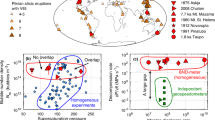Abstract
It is necessary to understand the diffusive behavior of the volatile phase in order to interpret the control mechanisms of the bubble size in volcanic rocks and the processes influencing the eruption itself. A simple numerical model is proposed, based on the time-dependency of the diffusion equation for a hollow sphere, to simulate incorporation of atmospheric noble gases in pumice for Vesuvian (i.e., Plinian) eruptions. During a Vesuvian eruption, melt fragments are ejected into the air. The resulting pumice samples collected after the eruption phase exhibit a significant incorporation of elementally and isotopically fractionated atmospheric noble gases. The noble gas content of the trapped gases then potentially provides useful data with which to constrain the timescales of cooling for the samples. The system can be adequately described as a diffusion process into a hollow sphere through the one dimensional diffusion equation for a spherically symmetrical geometry. Diffusion coefficients are time-dependent to include the effect of an exponential decay of temperature with time. The complexity of this system requires numerical resolution of the diffusion equation due to the diffusion coefficient temperature dependency. The outer boundary condition is fixed with a given noble gas concentration via an inhomogeneous Dirichlet boundary condition, while the inner boundary condition is set as a flux-free boundary. The numerical model allows the noble gas content, and thus the noble gas elemental and isotopic ratios entering the bubble, to be modeled as a function of time, hollow sphere thickness, diffusion coefficients, initial and final temperatures, and quench rate.




Similar content being viewed by others
References
Amalberti J, Burnard P, Laporte D, Tissandier L, Neuville DR (2016) Diffusion of noble gases (He, Ne, Ar) in silicate glasses close to the glass transition: distinct diffusion mechanisms. GCA 172:107–126
Anderson AT (1975) Some basaltic and andesitic gases. Rev Geophys Space Phys 13:37–55
Behrens H, Zhang Y (2001) Ar diffusion in hydrous silicic melts: implications for volatile diffusion mechanisms and fractionation. EPSL 192:363–376
Carroll MR, Stolper EM (1991) Argon solubility and diffusion in silica glass: implications for the solution behavior of molecular gases. Geochim Cosmochim Acta 55(1):211–225
Crank J (1975) The mathematics of diffusion, 2nd edn. Clarendon Press, Oxford, p p413
Dodson MH (1973) Closure temperature in cooling geochronological and petrological systems. Contrib Miner Petrol 40(3):259–274
Drapper DS, Carroll MR (1995) Argon diffusion and solubility in silicic glasses exposed to an Ar–He gas mixture. EPSL 132:15–24
Gonnermann HM, Mukhopadhyay S (2007) Non-equilibrium degassing and a primordial source for helium in ocean–island volcanism. Nature 449:1037–1040
Jaupart C (2000) Magma ascent at shallow levels. In: Sigurdsson H, Houghton B, McNutt S, Rymer H, Stix J (eds) Encyclopedia of volcanoes. Academic Press, pp 237–245
Kaneoka I (1980) Rare gas isotopes and mass fractionation: an indicator of gas transport into or from a magma. Earth Planet Sci Lett 48:284–292
Matsuda J, Matsubara K, Yajima H, Yamamoto K (1989) Anomalous Ne enrichment in obsidians and darwin glass: diffusion of noble gas in silica–rich glasses. GCA 53:3025–3033
Paonita A, Martelli M (2007) A new view of the He–Ar–CO2 degassing at mid-ocean ridges: homogeneous composition of magmas from the upper mantle. GCA 71:1747–1763
Pinti D, Wada N, Matsuda J (1999) Neon excess in pumice: volcanological implications. J Volcanol Geotherm Res 88:279–289
Press WH, Teukolsky SA, Vetterling WT, Flannery BP (2007) Numerical recipes: the art of scientific computing, 3rd edn. Cambridge University Press, New York
Proussevitch A, Sahagian D (2005) Bubbledrive-1: a numerical model of volcanic eruption mechanisms driven by disequilibrium magma degassing. J Volcanol Geoth Res 143(1):89–111
Ruzié L, Moreira M (2010) Magma degassing process during Plinian eruptions. J Volcanol Geotherm Res 192:142–150
Sparks RS (2003) Dynamics of magma degassing. Volcan Degassing 213:5–22
Sparks RS, Wilson J, Hulme G (1978) Theoretical modeling of the generation, movement, and emplacement of pyroclastic flows by column collapse. J Geophys Res 83:1727–1739
Tait S, Jaupart C, Vergniolle S (1989) Pressure, gas content and eruption periodicity of a shallow, crystallising magma chamber. EPSL 92:107–123
Toramaru A (1995) Numerical study of nucleation and growth of bubbles in viscous magmas. J Geophys Res 100:1913–1931
Van Orman JA, Grove TL, Shimizu N (1998) Uranium and thorium diffusion in diopside. EPSL 160:505–519
Whitman AG, Sparks RSJ (1986) Pumice. Bull Volcanol 48:209–233
Zhang Y, Cherniak DJ (2010) Diffusion in minerals and melts. Rev Mineral Geochem 72:p103
Acknowledgements
This work benefited from financial support of the Agence Nationale de la Recherche (DEGAZMAG project, contract no. ANR 2011 Blanc SIMI 5-6 003) and Région Lorraine. This is a CRPG contribution.
Author information
Authors and Affiliations
Corresponding author
Additional information
Dedicated to the memory of Pete Burnard who passed away in July 2015.
Rights and permissions
About this article
Cite this article
Amalberti, J., Antoine, X. & Burnard, P. Timescale Monitoring of Vesuvian Eruptions Using Numerical Modeling of the Diffusion Equation. Math Geosci 50, 417–429 (2018). https://doi.org/10.1007/s11004-018-9732-3
Received:
Accepted:
Published:
Issue Date:
DOI: https://doi.org/10.1007/s11004-018-9732-3




